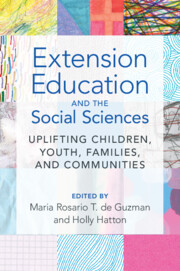Book contents
- Extension Education and the Social Sciences
- Extension Education and the Social Sciences
- Copyright page
- Contents
- Contributors
- Part I Overview of Extension and the Social Sciences
- Part II Addressing Key Issues in the Well-Being of Children, Youth, and Families
- Part III Looking Ahead: Emerging Issues and Trends
- Chapter 10 Cooperative Extension and Diversity
- Chapter 11 Reaching and Serving Underrepresented Families
- Chapter 12 Preparing the Next Generation of Extension Professionals
- Chapter 13 Extending Extension’s Outreach and Engagement with Social Media
- Index
- References
Chapter 12 - Preparing the Next Generation of Extension Professionals
from Part III - Looking Ahead: Emerging Issues and Trends
Published online by Cambridge University Press: 28 March 2024
- Extension Education and the Social Sciences
- Extension Education and the Social Sciences
- Copyright page
- Contents
- Contributors
- Part I Overview of Extension and the Social Sciences
- Part II Addressing Key Issues in the Well-Being of Children, Youth, and Families
- Part III Looking Ahead: Emerging Issues and Trends
- Chapter 10 Cooperative Extension and Diversity
- Chapter 11 Reaching and Serving Underrepresented Families
- Chapter 12 Preparing the Next Generation of Extension Professionals
- Chapter 13 Extending Extension’s Outreach and Engagement with Social Media
- Index
- References
Summary
This chapter addresses the critical question of how the Cooperative Extension System prepares the next generation of Extension professionals who will support the well-being of tomorrow’s children, youth, and families. This chapter details the career landscape of Extension in five parts. Part 1 presents a synopsis of career development research highlighting how a person identifies and advances in a career as well as different Extension careers to demonstrate the multiple career pathways and roles in Extension organizations. Part 2 provides a discussion of competencies and skills needed for successful Extension professionals. Parts 3, 4, and 5 explore each of the primary mechanisms for preparing the next generation of Extension professionals, including formal instruction through college programs, career development activities (e.g., internships); and education that occurs on or after hiring (e.g., onboarding, continuing professional development). Information from this chapter can help guide those interested in pursuing Extension careers, as well as those in leadership positions who oversee hiring and retaining talent for Extension.
- Type
- Chapter
- Information
- Extension Education and the Social SciencesUplifting Children, Youth, Families, and Communities, pp. 246 - 266Publisher: Cambridge University PressPrint publication year: 2024



